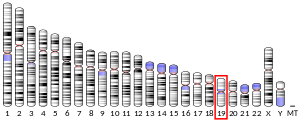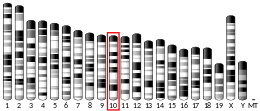S1PR4
Sphingosine-1-phosphate receptor 4 also known as S1PR4 is a human gene which encodes a G protein-coupled receptor which binds the lipid signaling molecule sphingosine 1-phosphate (S1P). Hence this receptor is also known as S1P4.[5]
Function
This gene is a member of the endothelial differentiation, G-protein-coupled (EDG) receptor gene family. EDG receptors bind lysophospholipids or lysosphingolipids as ligands, and are involved in cell signalling in many different cell types. This EDG receptor gene is intronless and is specifically expressed in the lymphoid tissue.[5]
gollark: It's not meaningful to just say "it can do 86970 passwords/second".
gollark: Yes, but bruteforcing *what*?
gollark: I can quite easily write you a program to generate all possible letter/number sequences faster than that.
gollark: What is it *doing* with these passwords, exactly?
gollark: ?????
See also
References
- GRCh38: Ensembl release 89: ENSG00000125910 - Ensembl, May 2017
- GRCm38: Ensembl release 89: ENSMUSG00000044199 - Ensembl, May 2017
- "Human PubMed Reference:". National Center for Biotechnology Information, U.S. National Library of Medicine.
- "Mouse PubMed Reference:". National Center for Biotechnology Information, U.S. National Library of Medicine.
- "Entrez Gene: S1PR4 Sphingosine-1-phosphate receptor 4".
Further reading
- Gräler MH, Bernhardt G, Lipp M (1998). "EDG6, a novel G-protein-coupled receptor related to receptors for bioactive lysophospholipids, is specifically expressed in lymphoid tissue". Genomics. 53 (2): 164–9. doi:10.1006/geno.1998.5491. PMID 9790765.
- Yamazaki Y, Kon J, Sato K, et al. (2000). "Edg-6 as a putative sphingosine 1-phosphate receptor coupling to Ca(2+) signaling pathway". Biochem. Biophys. Res. Commun. 268 (2): 583–9. doi:10.1006/bbrc.2000.2162. PMID 10679247.
- Van Brocklyn JR, Gräler MH, Bernhardt G, et al. (2000). "Sphingosine-1-phosphate is a ligand for the G protein-coupled receptor EDG-6". Blood. 95 (8): 2624–9. PMID 10753843.
- Idzko M, Panther E, Corinti S, et al. (2002). "Sphingosine 1-phosphate induces chemotaxis of immature and modulates cytokine-release in mature human dendritic cells for emergence of Th2 immune responses". FASEB J. 16 (6): 625–7. doi:10.1096/fj.01-0625fje. PMID 11919175.
- Kveberg L, Bryceson Y, Inngjerdingen M, et al. (2002). "Sphingosine 1 phosphate induces the chemotaxis of human natural killer cells. Role for heterotrimeric G proteins and phosphoinositide 3 kinases". Eur. J. Immunol. 32 (7): 1856–64. doi:10.1002/1521-4141(200207)32:7<1856::AID-IMMU1856>3.0.CO;2-B. PMID 12115604.
- Candelore MR, Wright MJ, Tota LM, et al. (2002). "Phytosphingosine 1-phosphate: a high affinity ligand for the S1P(4)/Edg-6 receptor". Biochem. Biophys. Res. Commun. 297 (3): 600–6. doi:10.1016/S0006-291X(02)02237-4. PMID 12270137.
- Contos JJ, Ye X, Sah VP, Chun J (2002). "Tandem genomic arrangement of a G protein (Gna15) and G protein-coupled receptor (s1p(4)/lp(C1)/Edg6) gene". FEBS Lett. 531 (1): 99–102. doi:10.1016/S0014-5793(02)03409-9. PMID 12401211.
- Strausberg RL, Feingold EA, Grouse LH, et al. (2003). "Generation and initial analysis of more than 15,000 full-length human and mouse cDNA sequences". Proc. Natl. Acad. Sci. U.S.A. 99 (26): 16899–903. Bibcode:2002PNAS...9916899M. doi:10.1073/pnas.242603899. PMC 139241. PMID 12477932.
- Vogler R, Sauer B, Kim DS, et al. (2003). "Sphingosine-1-phosphate and its potentially paradoxical effects on critical parameters of cutaneous wound healing". J. Invest. Dermatol. 120 (4): 693–700. doi:10.1046/j.1523-1747.2003.12096.x. PMID 12648236.
- Gräler MH, Grosse R, Kusch A, et al. (2003). "The sphingosine 1-phosphate receptor S1P4 regulates cell shape and motility via coupling to Gi and G12/13". J. Cell. Biochem. 89 (3): 507–19. doi:10.1002/jcb.10537. PMID 12761884.
- Kyi CS, Key SJ, Lloyd TW (2003). "Use of a nasogastric catheter to prevent soft tissue entanglement of the externally ported distractor arm". International Journal of Oral and Maxillofacial Surgery. 32 (3): 337–8. doi:10.1054/ijom.2003.0364. PMID 12767884.
- Holdsworth G, Osborne DA, Pham TT, et al. (2005). "A single amino acid determines preference between phospholipids and reveals length restriction for activation of the S1P4 receptor". BMC Biochem. 5: 12. doi:10.1186/1471-2091-5-12. PMC 514652. PMID 15298705.
- Gerhard DS, Wagner L, Feingold EA, et al. (2004). "The status, quality, and expansion of the NIH full-length cDNA project: the Mammalian Gene Collection (MGC)". Genome Res. 14 (10B): 2121–7. doi:10.1101/gr.2596504. PMC 528928. PMID 15489334.
- Rual JF, Venkatesan K, Hao T, et al. (2005). "Towards a proteome-scale map of the human protein-protein interaction network". Nature. 437 (7062): 1173–8. Bibcode:2005Natur.437.1173R. doi:10.1038/nature04209. PMID 16189514.
External links
- "Lysophospholipid Receptors: S1P4". IUPHAR Database of Receptors and Ion Channels. International Union of Basic and Clinical Pharmacology.
- Lysophospholipid+receptors at the US National Library of Medicine Medical Subject Headings (MeSH)
This article incorporates text from the United States National Library of Medicine, which is in the public domain.
This article is issued from Wikipedia. The text is licensed under Creative Commons - Attribution - Sharealike. Additional terms may apply for the media files.





